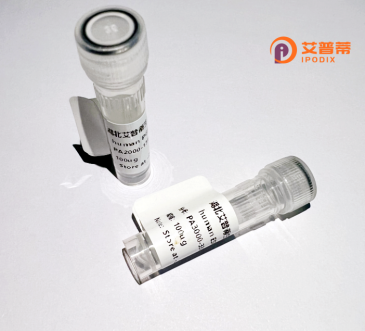
| 纯度 | >90%SDS-PAGE. |
| 种属 | Human |
| 靶点 | RGS18 |
| Uniprot No | Q9NS28 |
| 内毒素 | < 0.01EU/μg |
| 表达宿主 | E.coli |
| 表达区间 | 1-235 aa |
| 活性数据 | METTLLFFSQ INMCESKEKT FFKLIHGSGK EETSKEAKIR AKEKRNRLSL LVQKPEFHED TRSSRSGHLA KETRVSPEEA VKWGESFDKL LSHRDGLEAF TRFLKTEFSE ENIEFWIACE DFKKSKGPQQ IHLKAKAIYE KFIQTDAPKE VNLDFHTKEV ITNSITQPTL HSFDAAQSRV YQLMEQDSYT RFLKSDIYLD LMEGRPQRPT NLRRRSRSFT CNEFQDVQSD VAIWL |
| 分子量 | 27.5 kDa |
| 蛋白标签 | His tag N-Terminus |
| 缓冲液 | PBS, pH7.4, containing 0.01% SKL, 1mM DTT, 5% Trehalose and Proclin300. |
| 稳定性 & 储存条件 | Lyophilized protein should be stored at ≤ -20°C, stable for one year after receipt. Reconstituted protein solution can be stored at 2-8°C for 2-7 days. Aliquots of reconstituted samples are stable at ≤ -20°C for 3 months. |
| 复溶 | Always centrifuge tubes before opening.Do not mix by vortex or pipetting. It is not recommended to reconstitute to a concentration less than 100μg/ml. Dissolve the lyophilized protein in distilled water. Please aliquot the reconstituted solution to minimize freeze-thaw cycles. |
以下是关于重组人RGS18蛋白的3篇文献摘要概览:
1. **文献名称**:**"RGS18 acts as a negative regulator of platelet aggregation and thrombus formation"**
**作者**:Soulet, C.等(2008)
**摘要**:本研究揭示了RGS18在血小板信号通路中的作用,发现其通过抑制G蛋白偶联受体(GPCR)下游的Gαq信号传导,从而减少血小板活化和血栓形成,提示RGS18可能是抗血栓治疗的潜在靶点。
2. **文献名称**:**"Regulator of G-protein signaling 18 regulates myeloid cell proliferation and inflammation"**
**作者**:Bansal, G.等(2015)
**摘要**:研究显示,RGS18通过负向调控PI3K/Akt/mTOR通路影响髓系细胞的增殖与分化。RGS18缺失导致炎症因子(如IL-6、TNF-α)释放增加,表明其在免疫调控及髓系白血病中的潜在作用。
3. **文献名称**:**"Epigenetic silencing of RGS18 promotes cell proliferation in acute myeloid leukemia"**
**作者**:Yang, L.等(2017)
**摘要**:该文献发现,急性髓系白血病(AML)中RGS18因启动子区高甲基化而表达下调,其低表达与白血病细胞增殖加速和患者预后不良相关,恢复RGS18表达可抑制肿瘤生长。
Regulator of G-protein signaling 18 (RGS18) is a member of the RGS protein family, which act as critical negative regulators of G-protein-coupled receptor (GPCR) signaling pathways. Expressed predominantly in platelets, megakaryocytes, and certain hematopoietic cells, RGS18 accelerates the GTPase activity of Gα subunits (particularly Gαi/q) to terminate downstream signaling. This function positions RGS18 as a key modulator of cellular responses to extracellular stimuli, such as thrombin or ADP in platelets, influencing processes like platelet activation, aggregation, and thrombus formation. Its activity is tightly regulated through phosphorylation, protein interactions (e.g., with 14-3-3 proteins), and subcellular localization.
Studies highlight RGS18's role in hemostasis and thrombosis, with knockout mice exhibiting prolonged bleeding times and reduced arterial thrombosis, suggesting therapeutic potential for anticoagulant therapies. Additionally, aberrant RGS18 expression has been linked to hematological malignancies, indicating involvement in cell differentiation and apoptosis. Structural features include a conserved RGS domain for Gα binding and an N-terminal domain that mediates interactions with membrane receptors or scaffolding proteins. Despite progress, mechanisms underlying its tissue-specific regulation and pathophysiological roles in inflammation or cancer remain areas of active investigation. RGS18 thus represents a focal point for understanding GPCR-driven processes in both normal physiology and disease.
×